#Anti-melanin treatments
Text
Glutathione for Luminous Skin: A Comprehensive Guide to Skin Brightening Injections
When it comes to achieving flawless and radiant skin, many people explore various methods of skin lightening. One of the most popular options in this pursuit is skin whitening injections, particularly those that contain glutathione. The terms "glutathione injection," "glutathione for skin," and related phrases have gained significant popularity within the beauty industry. In this comprehensive guide, we will delve into all you need to know about skin whitening injections, covering their advantages, potential side effects, recommended dosages, and more.
Understanding Glutathione:
Before we dive into the realm of skin whitening injections, let's first grasp what glutathione is and why it's considered a game-changer in the quest for fairer skin.
Glutathione: The Ultimate Antioxidant
Glutathione is a potent antioxidant naturally present in the human body. It plays a crucial role in various biochemical processes, including detoxification, immune support, and shielding cells from damage caused by free radicals. In recent years, researchers have unveiled its remarkable ability to lighten and brighten the skin when administered through injections or capsules.
How Glutathione Skin Whitening Injections Function
Skin whitening injections containing glutathione work by inhibiting the production of melanin, the pigment responsible for our skin's color. As melanin production decreases, the skin gradually becomes lighter, resulting in a fairer complexion. These injections are administered intravenously or via intramuscular injections, and it's imperative to consult a qualified healthcare professional for this procedure.
Benefits of Glutathione for Skin
Skin Lightening: Glutathione injections are renowned for their capacity to lighten and brighten the skin, creating a more even complexion.
Reducing Hyperpigmentation: These injections can aid in diminishing the appearance of hyperpigmentation, dark spots, and acne scars.
Anti-Aging: Glutathione serves as an excellent anti-aging agent by reducing the visibility of fine lines and wrinkles, bestowing a youthful glow.
Skin Detoxification: Glutathione assists in detoxifying the skin, purging impurities and toxins, thereby yielding healthier-looking skin.
Glutathione Injection Dosage for Skin Whitening
The dosage of glutathione injections for skin whitening can vary according to individual requirements and the guidance of a healthcare professional. Adhering to the recommended dosage is crucial to achieve the desired results safely.
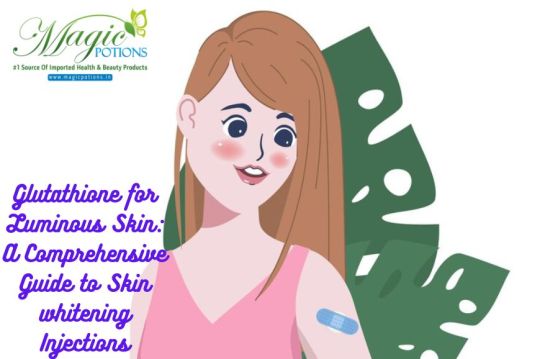
Cost of Glutathione Injections
The cost of glutathione injections can fluctuate widely based on factors such as location, clinic reputation, and the number of required sessions. It is vital to conduct research and select a reputable clinic that offers safe and effective treatments within your budget.
Potential Side Effects of Glutathione on Skin
Though generally considered safe, some individuals may experience minor side effects from glutathione injections, such as skin rashes or mild itching. Consulting a healthcare professional before commencing any skin whitening treatment is essential to discuss potential side effects and how to manage them.
Permanent Skin Whitening
Many individuals wonder if glutathione injections provide permanent skin whitening. While the effects of these injections are long-lasting, they are not entirely permanent. Maintenance sessions may be necessary to maintain the desired skin tone.
Other Skin Whitening Alternatives
In addition to glutathione injections, there are alternative methods for achieving skin lightening, such as skin lightening creams, serums, and capsules. Consulting with a dermatologist can assist you in selecting the most suitable option for your skin type and goals.
Conclusion:
Injections containing glutathione have gained popularity for their ability to provide a fairer and more radiant complexion. However, it is essential to approach these treatments with caution and seek guidance from a qualified healthcare professional. Remember that true beauty originates from within, and healthy, glowing skin reflects your overall well-being. Always prioritize safety and health in your pursuit of beautiful skin.
#Glutathione injections#Skin lightening treatments#IV skin whitening#Melanin reduction#Skin pigmentation therapy#Intravenous whitening#Skin brightening procedure#Antioxidant injections#Hyperpigmentation treatments#Safe skin lightening#Vitamin C skin whitening#Collagen and whitening#Skin rejuvenation injections#Anti-melanin treatments#Benefits of skin lightening injections#Side effects of whitening shots
0 notes
Text
Budget Anti-Aging Routine That Works | Glowing Skin Secrets | Health YAVA
youtube
#skin care#anti aging#skin products#skin health#skintight#skin treatment#anti aging serums#anti aging skincare#anti aging cream#glowingskin#skin care tips#skin care products#beauty#skin glow#skin&bones#skin picking#beauty products#melanin glowing#Youtube
0 notes
Text
Relatedly,ion like the way you guys keep assign the 'angel x devil/demon' trope to Ghostpr*wler fullstop and it feels icky with Punkflower too.G/p for those of you who aren't aware since i know the fandom has a lot minors in it do it being for a kids franchise is pretty much what Ghostflower antis think G/f is and that is the 'delicate pure white girl x macho corruptive black boy' snowbunny bs and i don't need to tell you why calling a white girl who's canonically punk and EXTREMELY rough around the edges an angel and a black boy who turned to vigilanteism because his dad was murdered a demon is antiblack to say the least.And for Punkflower,sorry but even to other black Spiderverse fans,y'all are WILDIN' with those 'bad boy Hobie' allegations-He's an activist,not a high school fuckboy.I get the intial confusion but i don't see how after watching the movie you'd think Hobie is any kind of shallow trope instead of an incredibly realistic and important depiction of black punk teenagers and that includes not caring about societal ideas of romance.He's not a 'bad boy',he's a troubled but good kid and imma need y'all to dile it back with him and Miles G too cause you're not only being racist but also infantalizing Gwen for her whiteness and Miles for his femininity and there's an added layer of grossness because the Gwen treatment is often ciscentric and the Miles treatment whitecentric and again,no explatation needed.Stop writing Gwen like a cis Karen instead of a surprisingly likable white girl who's also trans and Miles as a melaninated Tom Holland instead of a soft black femme and Miles G and Hobie as anything other than black trauma rep I'M LITERALLY BEGGING Y'ALL
#spiderband#antighostprowler#antipunkprowler#ghostflower#punkflower#ghostpunk#gwen stacy#miles g morales#hobie brown#pro ghostflower#pro gwen stacy#miles g defense squad#miles morales deserves better#hobie brown deserves better#atsv#spiderman#trans#autistic girl summer#antiblackness#transmisogyny#t4t punkflower#💌#summerposting
18 notes
·
View notes
Text
By: Matt Johnson
Published: Jan 27, 2023
“Christopher Hitchens: From socialist to neocon.” It was an irresistible headline because it’s a story that has been told over and over again. The novelist Julian Barnes called this phenomenon the “ritual shuffle to the right.” Richard Seymour, who wrote a book-length attack on Hitchens, says his subject belongs to a “recognisable type: a left-wing defector with a soft spot for empire.” By presenting Hitchens as a tedious archetype, hobbling away from radicalism and toward some inevitable reactionary terminus, his opponents didn’t have to contend with his arguments or confront the potentially destabilizing fact that some of his principles called their own into question.
Hitchens, who died in 2011, didn’t make it easy on the apostate hunters. To many, he was a “coarser version of [conservative commentator] Norman Podhoretz” when he talked about Iraq, and a radical humanist truth-teller when he went on Fox News to lambaste the Christian right: “If you gave Falwell an enema,” he told Sean Hannity the day after Jerry Falwell’s death, “he could be buried in a matchbox.” Then he gave Islam the same treatment, and he was suddenly a drooling neocon again. He defied easy categorization: a socialist who spurned ideology, an internationalist who became a patriot, a man of the left who was reviled by the left.
The left isn’t a single amorphous entity—it’s a vast constellation of (often conflicting) ideas and principles. Hitchens’s style of left-wing radicalism is now out of fashion, but it has a long and venerable history: George Orwell’s unwavering opposition to totalitarianism and censorship, Bayard Rustin’s advocacy for universal civil rights without appealing to tribalism and identity politics, the post-communist anti-totalitarianism that emerged on the European left in the second half of the twentieth century.
Hitchens described himself as a “First Amendment absolutist,” an echo of historic left-wing struggles for free expression—from Eugene V. Debs’s assertion of his right to dissent during World War I to the Berkeley Free Speech Movement. Hitchens argued that unfettered free speech and inquiry would always make civil society stronger. When he wrote the introduction to his collection of essays For the Sake of Argument in 1993, he had a specific left-wing tradition in mind: the left of Orwell and Victor Serge and C.L.R. James, which simultaneously opposed Stalinism, fascism, and imperialism in the twentieth century, and which stood for “individual and collective emancipation, self-determination and internationalism.”
Hitchens’ most fundamental political and moral conviction was universalism. He loathed nationalism and argued that the international system should be built around a “common standard for justice and ethics”—a standard that should apply to Henry Kissinger just as it should apply to Slobodan Milošević and Saddam Hussein. He believed in the concept of global citizenship, which is why he firmly supported international institutions like the European Union. He didn’t just despise religion because he regarded it as a form of totalitarianism—he also recognized that it’s an infinitely replenishable wellspring of tribal hatred.
He also opposed identity politics, because he didn’t think our social and civic lives should be reduced to rigid categories based on melanin, X chromosomes, and sexuality. He recognized that the Enlightenment values of individual rights, freedom of expression and conscience, humanism, pluralism, and democracy are universal—they provide the most stable, just, and rational foundation for any civil society, whether they’re observed in America or Europe or Iraq.
And yes, he argued that these values are for export. Hitchens believed in universal human rights. This is why, at a time when his comrades were still manning the barricades against the “imperial” West after the Cold War, he argued that the North Atlantic Treaty Organization should intervene to stop a genocidal assault on Bosnia. It’s why he argued that American power could be used to defend human rights and promote democracy. As many on the Western left built their politics around incessant condemnations of their own societies as racist, exploitative, oligarchic, and imperialistic, Hitchens recognized the difference between self-criticism and self-flagellation.
-
One of the reasons Orwell accumulated many left-wing enemies in his time was the fact that his criticisms of his own “side” were grounded in authentic left-wing principles. When he argued that many socialists had no connection to or understanding of the actual working class in Britain, the observation stung because it was true. Orwell’s arguments continue to sting today. In his 1945 essay “Notes on Nationalism,” he criticized the left-wing intellectuals who enjoy “seeing their own country humiliated” and “follow the principle that any faction backed by Britain must be in the wrong.” Among some of these intellectuals, Orwell wrote: “One finds that they do not by any means express impartial disapproval but are directed almost entirely against Britain and the United States. Moreover they do not as a rule condemn violence as such, but only violence used in defense of the Western countries.”
Hitchens observed that many on today’s left are motivated by the same principle: “Nothing will make us fight against an evil if that fight forces us to go to the same corner as our own government.” This is a predictable manifestation of what the American political theorist Michael Walzer calls the “default position” of the left: a purportedly “anti-imperialist and anti-militarist” position inclined toward the view that “everything that goes wrong in the world is America’s fault.”
Indeed, the tendency to ignore and rationalize even the most egregious violence and authoritarianism abroad in favor of an obsessive emphasis on the crimes and blunders of Western governments has become a reflex. Much of the left has been captured by a strange mix of sectarian and authoritarian impulses: a myopic emphasis on identitarianism and group rights over the individual; an orientation toward subjectivity and tribalism over objectivity and universalism; and demands for political orthodoxy enforced by repressive tactics like the suppression of speech.
These left-wing pathologies are particularly corrosive today because they give right-wing nationalists and populists on both sides of the Atlantic—whose rise over the past several years has been characterized by hostility to democratic norms and institutions, rampant xenophobia, and other forms of illiberalism—an opportunity to claim that those who oppose them are the true authoritarians. Hitchens was prescient about the ascendance of right-wing populism in the West, from the emergence of demagogues who exploit cultural grievances and racial resentments to the bitter parochialism of “America First” nationalism. He understood that the left could only defeat these noxious political forces by rediscovering its best traditions: support for free expression, pluralism, and universalism—the values of the Enlightenment.
Hitchens closes his book Why Orwell Matters with the following observation: “What he [Orwell] illustrates, by his commitment to language as the partner of truth, is that ‘views’ do not really count; that it matters not what you think, but how you think; and that politics are relatively unimportant, while principles have a way of enduring, as do the few irreducible individuals who maintain allegiance to them.” Despite the pervasive idea that Hitchens exchanged one set of convictions for another by the end of his life, his commitment to his core principles never wavered. They are principles that today’s left must rediscover.
Matt Johnson is a journalist and the author of the forthcoming book, How Hitchens Can Save the Left: Rediscovering Fearless Liberalism in an Age of Counter-Enlightenment, from which this piece is excerpted.
#Matt Johnson#How Hitchens Can Save the Left#liberalism#liberal ethics#universalism#pluralism#freedom of speech#freedom of expression#free speech#first amendment#identity politics#identarianism#woke authoritarianism#authoritarianism#tribalism#religion is a mental illness
22 notes
·
View notes
Text
Home Remedies for Skin Sunspots: Secret Natural Solutions Revealed
Sunspots are flat brown patches that appear on parts of skin exposed to the sun over time. They are sometimes referred to as age spots or solar lentigines.
These are frequent places that many people find unpleasant from a cosmetic standpoint, especially as they become older.
At least there are a lot of DIY treatments that can help sunspots look less noticeable and balance out skin tone.

Home Remedies for Skin Sunspots
Understand Sunspots
Long exposure to ultraviolet (UV) radiation can cause sunspots, a frequent skin problem that is caused by an increase in melanin production in the skin.
The pigment called melanin, which gives our skin its color, can result in the formation of dark spots when it is produced in excess.
Sunspots usually develop on the face, hands, shoulders, and arms areas of the body that are exposed to the sun the most.
Natural Ingredients to Treat Sunspots
Sunspots can be effectively reduced without the use of harsh chemicals by using natural components.
The following are a few of the top natural remedies,
1. Lemon Juice
Lemon juice, which is high in vitamin C, gradually lightens sunspots by acting as a natural bleaching agent.
Lemon juice's citric acid helps exfoliate the skin by removing dead skin cells and encouraging the development of new, lighter skin.
2. Aloe Vera
Aloe vera is well-known for its healing and calming qualities, which may help in improving skin health and lightening sunspots.
Compounds found in aloe vera can help in promoting skin renewal and reduce pigmentation.
3. Apple Cider Vinegar
Because of its acetic acid content, apple cider vinegar is a well-liked treatment for skin tone evenness and sunspot removal.
Also having astringent qualities, apple cider vinegar helps to tighten and cleanse the skin.
4. Green Tea Extract
Antioxidants found in green tea extract can diminish sunspots and decrease the synthesis of melanin.
Green tea's anti-inflammatory qualities may also help in soothing and shielding the skin from more harm.

5. Turmeric
Curcumin, the main component of turmeric, has strong anti-inflammatory and skin-lightening effects.
Skin tone can be evened out and sunspots can be less noticeable with the use of turmeric.
6. Vitamin E
Strong antioxidant vitamin E can help heal damaged skin and lessen the visibility of sunspots.
It is a fantastic treatment for sun-damaged skin since it encourages skin regeneration and healing.
more >>>
2 notes
·
View notes
Note
You know I think another thing about white liberals supporting conservatism in different cultures is they literally don’t know what conservatives believe. They know they’re racist and…that’s about it. The whole block and stay safe culture and just making up things about their enemies has left them completely oblivious to what these people actually think. They could not recognize conservative views if told them point blank
It’s dangerous because of the stronghold white liberals have on media, because it convinces everyone decent (people of melanin included) to ignore real world conservatism because it’s too complicated and scary instead of doing the hard work of dismantling it. That includes addressing what might be the internalized conservative within and a lot of people don’t wanna do that. These white liberals who neatly blanket blame everything on white racism and colonialism as if for example Sharia Law doesn’t exist and isn’t proof that people of melanin can be plenty conservative all on our own. Non white liberals are in denial about it too. Like you’re just doing what they do and cherry picking the parts of the narrative that work for you
Block to stay safe culture has non white men getting away with murder because to some of these “activists” as long as you’re anti-racist you must be a decent person. Lol the worst misogyny and treatment overall that I’ve experienced in my life has been from Latino and black men who according to liberal queer theory are just pronouns away from being the most oppressed demographic on Earth as if systemic misogyny just went away
17 notes
·
View notes
Note
hot take? rantish and long and whiney? sorry i have to get this off my chest
is it wrong but i kinda think or well believe that as a WOC from america, maneskin would benefit if they began to look at and think about racism the way MOST americans do from my own experience i have face different levels of racism but the stories you hear about BIPOC over in europe is close to a real life horror story at times, i am melaninated for reference and generally where i am people can AWFUL but MOST are kind and knowledgeable especially the younger crowd let me explain (rant ahead, this is written by a woc with intersectional identities, i basically check nearly every box)
we have WAY more BIPOC here in the states than over in europe, were more exposed to different cultures in many parts of the country and i mean think about it country that is MAJORITY white vs the USA
ive had white europeans tells me they never fear the cops in their country. . . like no duh ur not their target dumbass in general it is VERY easy be ignorant to an issue in a place where you, your family, your friends and peers arent affected by that issue and that makes it easier to believe it doesnt exist and/or be ignorant to it since most likely there isnt anyone or anything challenging the problematic values or mindsets especially in a place like europe where entire communities reinforce certain racist ideals because its a mindset that gets passed down even now and if they are brought up to believe that its okay and the only way anyone ever thinks in their minds, why change it? so often when it is challenged its either seen as a threat to a whole way of world perspective taught and reinforced by everyone around them and even online depending on what corner they occupy and the idea of them as a good person since that way of thinking is how "good" people think or it is seen as an opportunity of some sort to change and expand (this can happen anywhere btw but more often in europe)
in my experience americans are much more willing to do the latter depending on the person of course because not talking about an issue or never being negatively effected by it does not mean it doesnt exist and we are much more willing to admit that we have issue of some kind for the most part while many europeans in my experience deny it outright or only acknowledge it to some extent since they often have NO CLUE what the issue truly encapsulates and looks like or believe its an issue that can be justified, often there is many instances of virtue signaling hiding the racism/islamophobia/anti-Semitic/anti-roma behind the over-focusing on things they have that we do not like gun laws and free healthcare and "not having trump" as if that makes up for the horrors that the continent as a whole is responsible for the continent that colonized and enslaved majority of the world and either directly or indirectly contributed to the suffering and inhumane treatment of the people who were violently colonized and enslaved and also was also the site of many horrors
the USA has done horrific things that isnt even acknowledged and we are not perfect but at the very least many are willing to admit this fact and admit that many are trying to improve
condemning the USA more than one would condemn a European country leads to the belief that one is better, smarter and more civilized than the other buying into the stereotype of the civilized european vs the savage american which turns racist VERY QUICLY and will/already has bleed unto other countries being lesser than a european countries not only that but anti-american xenophobia turns to racism extremely easily and quickly because of how we have a larger BIPOC population in comparison
side note how tf were yall so racist publicly and privately and to a point yall made a biracial black woman move BACK to america
rant over back to maneskin
i think if they did, many things would improve and they would be more outspoken and just understanding of what exactly they have done wrong, they are great people they just need help and to be educated on these issues where they might be lacking or ignorant of since they are 4 white europeans who have a grasp and ideas on the basics of not being racists, but i as a WOC feel there is room to improve especially being a WOC in the fandom the sheer whiteness of the fandom and spaces in events makes me uneasy and at times afraid of experiencing hatred
maybe its me being whiney but i kind of hope to see them move on to anti-racism and improving where i feel they lack they are not racists but thats not enough and i know they can improve, they are amazing talented and smart people they just need a little boost and push in the right direction so they can fix the things we are aware of that they have done wrong and make amends and take accountability because at times i see them say one thing or repost something but i instantly remember the things they have done wrong and it makes my mind wander to what they say or do or have said and done in the past or when theres no other marginalized people around
i also have anxiety and other issues so maybe i am being whiney and looking too deeply but i love them so much and i want to see them grow and improve and take the world by storm i just wish they could get over this one thing you know?
“as a WOC feel there is room to improve especially being a WOC in the fandom the sheer whiteness of the fandom and spaces in events makes me uneasy and at times afraid of experiencing hatred”
^ this!!!
Definitely not whiny at all. White people make POC feel like they’re complaining when really they just don’t want to be faced with the consequences of the racism they perpetuate.
Maybe it’s because I’m a cynic by nature, but anon has for faith in the moral compass of these four funky Italians that I currently do. Or maybe I’ve lost perspective because I’m still livid at Damiano for selling out in this interview.
youtube
“And of course we don’t wanna, like, influence anyone with political ideas.”
It’s a modern fucking miracle he could even fit into the car that drive them with the size of that privilege.
5 notes
·
View notes
Text
Discover the anti-dark spot care routine!
Many women want to get rid of it for aesthetic reasons. Discover your new anti-dark spot routine to find a clear and even complexion.
Whatever your skin type or age, dark spots are inevitable due to exposure to UV rays, hormonal disorders and aging, are caused by a disorder of the pigment cell of the skin, it is the overproduction of melanin, it can appear without warning, even if you take care of your skin on a daily basis.
Discover the anti-dark spot care routine!

For oily, acne-prone skin:
Living with acne-prone skin can impact the psychological state of people who suffer from this problem, as acne lesions can deform the dermis and cause unsightly scars.
To obtain a clear and even complexion, without resorting to invasive treatments on the pigmentation of the skin, opt for treatments with proven effectiveness.
D-WHITE has developed complementary daily care products to help fight spots caused by pimples, or whatever their origin:
Lemon Brightening Exfoliating Bar:
Eliminates dead skin
Brighten the complexion
Mattifying
Intense care cream for oily skin:
Anti-inflammatories and Anti-oxidants
Reduces scars
Reduces pigment spots
Anti-dark spot Exfoliating Serum:
Inhibits the production of melanin
Brighten the complexion
Hydrate
For Normal to Dry skin:
Wheat Lightening Exfoliating Bar:
Repairs the hydrolipidic film of the skin
Protects free radicals
Hydrate
The Depigmenting Cream:
Inhibits melanin production
Brighten the complexion
Hydrate

Among the habits to have to avoid brown spots, cleaning your face meticulously is an essential step, because when the skin is clean and rid of its toxins it becomes more resistant to external aggressions and free radicals. This helps to avoid pigmentation spots as much as possible.
So which routine is right for you?
For more information visit our website here
2 notes
·
View notes
Text
Neurodegenerative Diseases
Neurodegenerative diseases are incurable and debilitating conditions that result in progressive degeneration and/or death of nerve cells.
- Parkinson’s Disease (PD)
- Alzheimer’s Disease (AD)
- Huntington’s Disease (HD)
- Amyotrophic Lateral Sclerosis (ALS)
Stephen Hawking lost control of his skeletal muscles due to ALS.
Parkinson’s Disease
Parkinson’s disease (PD) is a chronic, progressive, neurodegenerative disorder.
- First described by James Parkinson, an English doctor in 1817.
- Risk of PD increases with age, but an early-onset variant occurs before age 40.
Diagnosis
- neurological symptoms
- imaging tests
- reaction to anti-Parkinson’s drug L-DOPA
if symptoms improve with L-DOPA, then patient has PD.
- post-mortem examination of the brain
Symptoms
(A) Motor
- Tremor: The most visible outward sign of PD is a tremor that occurs when limbs are relaxed, but disappears with intentional movement.
- Rigidity: shuffling gait caused by rigid joints.
- Postural instability: Disorders of posture and impaired balance may cause patients to lean forward or backward when upright, and have stooped posture.
- Slowness of movement
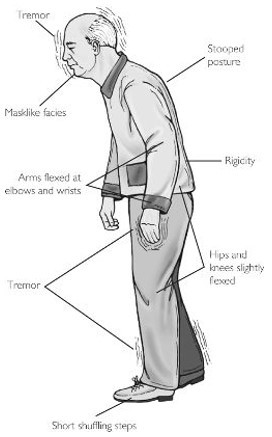
- Akinesia: difficulty initiating movement
- Involuntary movements
- Less movement of facial muscles: reduces the range of facial expressions possible. Many patients with PD are described as “stone-faced.”
- Speech disturbances: decreased speaking volume, and monotonous speech or uncontrollable acceleration of speech.
(B) Cognitive/Emotional
- Impoverishment of feeling, motive, and attention
- Cognitive slowing
- Possible/occasional anxiety
- Parkinson’s patients may also develop dementia (Parkinson’s disease dementia, or PDD). This is difficult to distinguish from comorbid Alzheimer’s disease (AD).
Post-mortem Examination
- A definitive diagnosis of PD is currently not possible until after death.
- Depletion of melanin due to the death of neurons in the substantia nigra in Parkinson’s disease is typically indicated by loss of brown color in this area.
- Microscopic examination reveals presence of Lewy bodies.

Brain Imaging
- A marker or test that reliably indicates PD in live patients would be useful for determining treatment options.
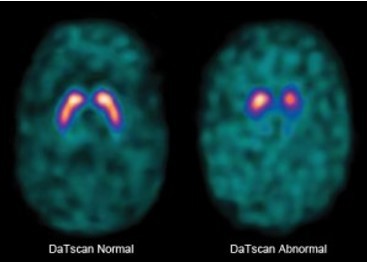
- DaTscan was approved by the FDA in 2011 for striatal dopamine transport visualization to assist in the evaluation of adult patients with suspected PD.
Unfortunately, this is prohibitively expensive, and dopamine transporter can be reduced in other neurological diseases, so the results are not conclusive.
Pathophysiology
- Aside from the resting tremor, all motor symptoms are explained by loss of dopaminergic cells in the substantia nigra.
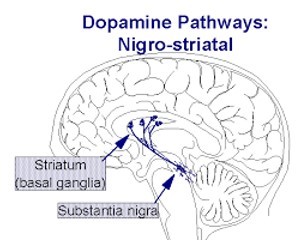
- As a result, there is insufficient amount of dopamine in the basal ganglia.
- Malfunction of the basal ganglia results in motor disturbances.
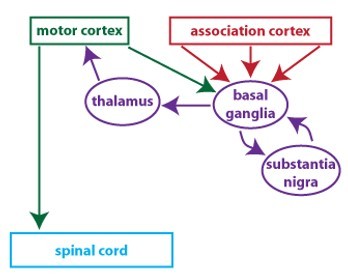
Several processes contribute to degeneration of neurons, including mitochondrial dysfunction, oxidative stress, inflammation, excitotoxicity, protein misfolding.
Protein Misfolding
- Protein folding is a physical process of the formation of a highly organized molecular structure, with a characteristic and thermodynamically stable conformation, by a polypeptide chain.
- In many neurodenerative diseases, proteins that do not fold properly (misfolded proteins) produce pathological changes in the brain.
- In PD, pathology is linked to misfolded a-synuclein.
- In healthy cells, a-synuclein mediates vesicle movement at axon terminals.

Lewy Bodies
Lewy bodies = dense, circular clusters (or aggregates) of protein within cells.
- They consist of a-snyuclein and other proteins.
- Misfolded a-synuclein molecules tend to aggregate and form Lewy bodies.
- They interrupt cell function and trigger apoptotic cell death.
- They can be detected during post-mortem examination of PD brain.

Spread of Parkinson’s Disease in the Brain
(1) Olfactory structures = sense of smell is lost.
(2) Brainstem nuclei: the raphe (serotonergic neurons) and locus coeruleus (norepinephrine neurons).
(3) Substantia nigra, amygdala = motor symptoms begin at this stage.
(4) Temporal cortex, premotor cortex
(5) Other sensory cortices, motor cortex
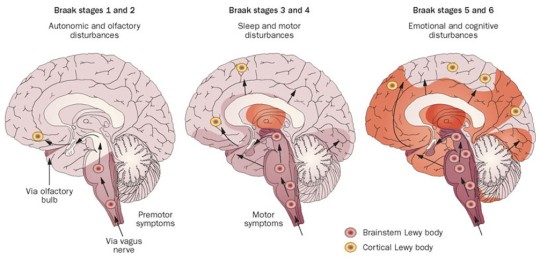
Etiology of Parkinson’s Disease
Although there are genetic and environmental risk factors, a definitive cause has not yet been discovered.
(A) Genetics
15% of PD patients reported an affected family member.
5-10% of PD cases are linked to known mutations.
(B) Aging
Due to an aging population, researchers project the number of people with Parkinson’s will double by 2040.
(C) Traumatic brain injury
Researchers looked at the medical records of >300,000 veterans and found that mild TBI increases risk of PD by 56%, while moderate to severe TBI increases risk of PD by 84%.
(D) Environmental factors
MPP+
1976: Bad batch of synthetic heroin (containing MPTP contaminant) produced “instant” Parkinson’s.
- MPTP is oxidized to MPP+ that damages dopaminergic cells.
- Paraquat is structurally similar to MPP+ and is currently used as an herbicide.
A known fast-acting inducer of Parkinson’s disease in primate brains
In 2011, a US National Institutes of Health study showed a link between paraquat use and Parkinson’s disease in farm workers.
Paraquat has been banned in the European Union since 2007. It can be used in the US with a license.
TCE
- Trichloroethylene, a solvent used to clean metals and remove stains, has exactly the same effect on human brains.
- It is still widely used and is detectable in high concentrations in groundwater.
- There have been many lawsuits about TCE groundwater and drinking water that’s been contaminated by industrial discharge.
Behavioral Treatments
physical therapy
exercise programs
speech therapy
Pharmacological Treatments
- drugs that increase dopamine response:
L-DOPA
Dopamine receptor agonists
MAO inhibitors
Levodopa (L-DOPA)
metabolite of the amino acid tyrosine
immediate precursor of DA in its metabolic pathway
L-DOPA can cross the blood-brain barrier, but DA cannot.
L-DOPA is extremely effective, compared to other DA agonists.
Side effects include motor fluctuations, dyskinesias, and unwanted movements (such as severe tics)
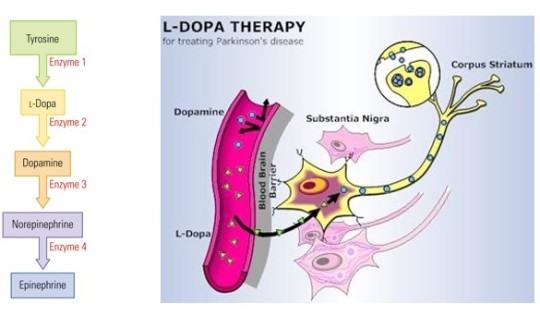
Other treatments are also aimed at increasing dopamine signaling in the brain.
- Dopamine receptor agonists bind to dopaminergic post-synaptic receptors in the brain, have similar effects to levodopa.
Bromocriptine, apomorphine
Side effects: impulse control disorders, such as compulsive sexual activity, compulsive eating, pathological shopping, and gambling
- Monoamine oxidase B (MAO-B) inhibitors prevent breakdown of dopamine (ex. Selegeline)
Surgical Treatments
These treatments reduce rigidity and tremor.
Lesioning of the basal ganglia
Deep brain stimulation of the basal ganglia
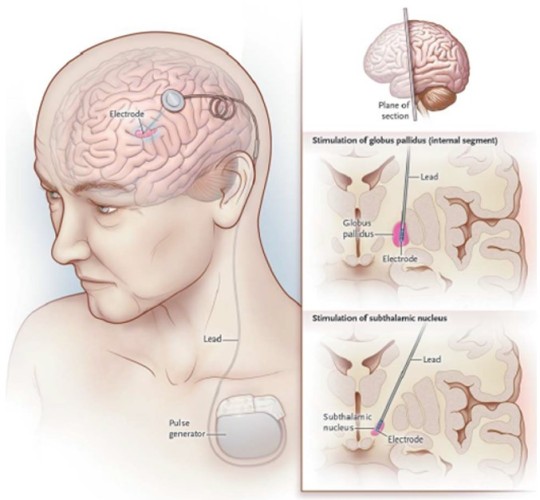
Stem Cell Treatment
Stem cells can be used in a lab to generate many other types of cells, including dopamine cells. Introducing new dopamine cells into the brain may help replace lost cells in PD.
October 2019: In Kyoto, Dr. Takahashi and his staff completed the first transplant into a human brain. They plan to complete six additional operations by 2022.
They used induced pluripotent stem cells (iPS cells) are derived from adult cells (usually from skin or blood) and can be manipulated to act like stem cells.
- In the US, Dr. Studer is about to move to clinical trials with dopamine cells derived from human embryonic stem cells.
Alzheimer’s Disease
Alzheimer’s disease (AD) is a chronic, progressive dementia disorder that is much more widespread than PD.
- Dementia is an acquired and persistent syndrome of intellectual impairment.
- Described in 1907 by Alois Alzheimer
- Due to aging population, cases of AD in United States are expected to increase.
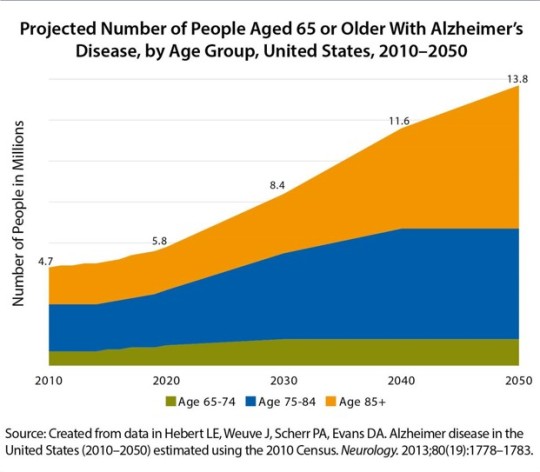
- Alzheimer’s is preceded by mild cognitive impairment (MCI).
- While all cases of AD are precede by MCI, not all cases of MCI develop into AD.
- As MCI progresses to AD, the first symptom is general forgetfulness, leading to progressive loss of memory.
Diagnosis
Neurological symptoms
Imaging tests
Post-mortem examination of the brain
Early Symptoms
Memory loss that disrupts daily life
Misplacing things and losing the ability to retrace steps
Challenges in planning or solving problems
Confusion with time or place
New problems with words in speaking or writing
Decreased or poor judgment
Withdrawal from work or social activities
Changes in mood and personality
Later Symptoms
Physiological problems: disrupted sleep, incontinence, and difficulty swallowing are seen
Psychiatric symptoms: delusions, hallucinations, depressed mood, and agitation (including violent outbursts)
Communication skills are diminished.
Advanced Stages
- Much of our sense of “self” comes from our memory and cognitive function, which is lost in those with advancing AD.
- AD will eventually take away completely the ability to use language, interact with or even recognize family and friends, or live independently.
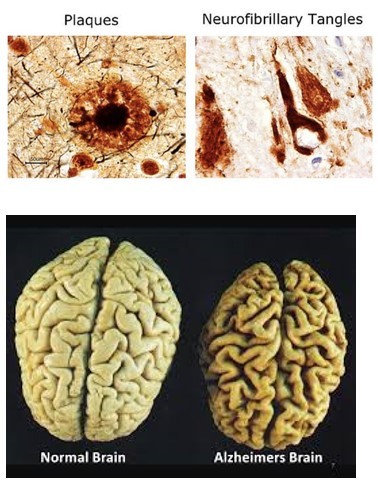
- AD cannot be definitively diagnosed until after death. A histopathologic confirmation including a microscopic examination of brain tissue is required.

PET Scan with PiB compound
- Imaging of pathological A-beta protein with the help of Pittsburgh compound B can potentially help with diagnosis.
Etiology
Risk factors for AD include:
Advanced age
Family history of dementia or AD (1-5% genetic predisposition)
Obesity, untreated hypertension, high cholesterol, chronic stress, and sedentary lifestyle
Head trauma or hypoxic brain injury, depression, bipolar disorder, or PTSD
Environmental toxins (ex. aluminum)
Slow-acting viral infection
Cortical Degeneration
- Most heavily affected areas are the entorhinal cortex, some parts of the frontal cortex, hippocampus, inferior temporal cortex, and posterior parietal cortex.
- The primary sensory and motor areas are spared, as well as most of the brainstem, cerebellum, and spinal cord.

- Cerebral atrophy may be due in large part to the loss of dendritic arborization.
- A significant loss of synapses (up to 45%) may be the basis for the cognitive deficits.

- Cellular pathologies and neuronal cell loss in AD are associated with pathological formations in the brain:
Amyloid plaques (located in the extracellular space, also found in aging brains)
Neurofibrillary tangles (located inside neurons)
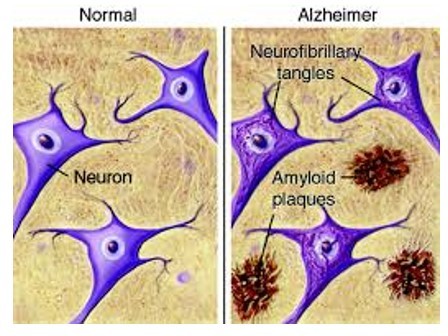
Amyloid plaques = fibrous deposits around neuronal cells
- A plaque has a core of beta-amyloid protein surrounded by abnormal processes (dendrites or axons), with microglial cells or reactive astrocytes on the periphery.
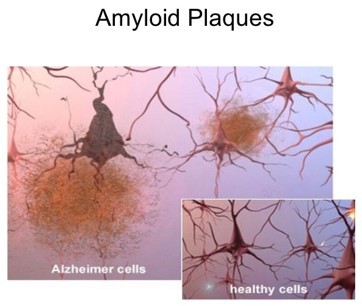
- Molecules of beta-amyloid protein (or A-beta) are pathologically misfolded and tend to aggregate.
- Protein misfolding is a pathology common for many diseases (e.g. Parkinson’s).
Neurofibrillary tangles (NFTs) = fibrous inclusions in neuron cytoplasm.
- Pyramidal neurons are particularly susceptible.
- The misfolded tau protein is the main component. Tau protein maintains the stability of axonal microtubules.
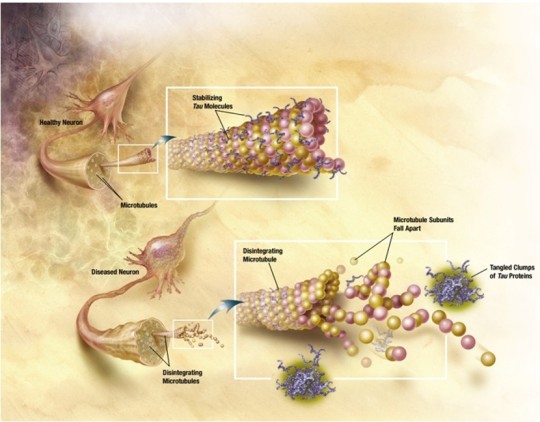
Treatments
- Currently, there are no available treatments that stop or reverse the progression of the disease, only treatments that help the symptoms.
(A) Behavioral/Lifestyle:
Mental stimulation
Physical exercise
Balanced diet
(B) Pharmacological:
- Acetylcholinesterase inhibitors increase amount of acetylcholine in the synaptic cleft (Donepezil, tacrine, galantamine).
- NMDA receptor inhibitor (Memantine)

(C) Very New/Future Treatments
- Aducanumab (brand name Aduhelm)
cleared by the FDA on June 7, 2021
developed by biotech company Biogen in Cambridge, Mass
antibody therapy that targets amyloid plaques
first approved drug that treats a cause of the neurodegenerative disease, rather than just the symptoms
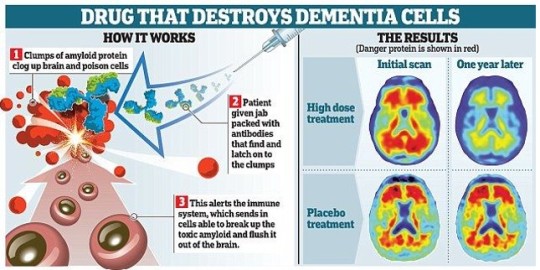
- Antibodies to A-beta
currently in clinical trials
Solanezumab is a monoclonal antibody being investigated by Eli Lilly as a neuroprotector for patients with AD. It failed in patients with moderate AD, but the trial for patients with mild AD (should have been) finalized in 2020. {note: if you know whether these trials were finalized, delayed, or terminated, let me know in the comments!}
- Drugs that block enzyme responsible for production of A-beta
September 2019: companies Biogen and Eisai announced termination of Phase 3 trial of Elenbecestat, another failure :(
- Antibodies to tau
currently in animal studies (preclinical phase)
Antibodies could decrease levels of phosphorylated tau proteins in mouse brains.
2 notes
·
View notes
Text
Exploring the Advantages, Risks, and Costs of Glutathione Injections for Skin Whitening
Skin whitening has become quite a talked-about topic, with many people looking for ways to get fairer skin. One method that's gained popularity is using skin whitening injections, especially those with glutathione. In this article, we'll explore these injections, their benefits, potential side effects, and how much they cost in India.
What are Skin Whitening Injections?
Skin whitening injections, often called glutathione injections, are cosmetic procedures where glutathione, a powerful antioxidant found in the body, is given through the veins. These injections claim to make the skin lighter by reducing the pigment responsible for skin color, melanin.
Benefits of Glutathione Skin Whitening Injections:
Skin Lightening: Glutathione injections are believed to gradually make the skin fairer.
Reduced Pigmentation: They can help lessen issues like dark spots, acne scars, and hyperpigmentation.
Improved Skin Texture: Glutathione can make your skin smoother and more youthful.
Anti-Aging: Being an antioxidant, glutathione can fight free radicals and potentially reduce signs of aging, like fine lines and wrinkles.
Boosted Confidence: Achieving your desired skin tone can boost your confidence and self-esteem.
Potential Side Effects:
While these injections are generally safe, some side effects may include:
Skin Dryness: Some people may experience dry or flaky skin.
Allergic Reactions: Rarely, individuals may have allergies to the injection components.
Skin Sensitivity: Increased sensitivity to sunlight is possible, so proper sun protection is important.
Temporary Effects: The effects of glutathione injections aren't permanent and require maintenance.
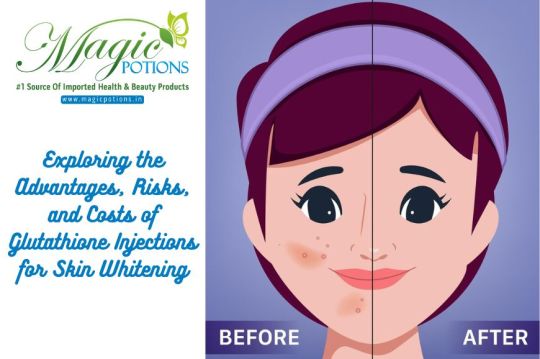
Glutathione Injection Price in India:
The cost of glutathione injections in India can vary widely based on factors like the brand, dosage, and where you get them. On average, a single session can range from INR 2,000 to INR 5,000 or even more.
Conclusion:
Skin whitening injections, especially those with glutathione, have become a popular choice for those seeking fairer skin. While they offer benefits like lighter skin and improved texture, it's crucial to consider potential side effects and the need for ongoing maintenance. Before getting any skin whitening procedure, it's a good idea to consult with a qualified dermatologist or healthcare professional to ensure it's safe and suitable for your skin type.
#Glutathione injections#Skin lightening treatments#IV skin whitening#Melanin reduction#Skin pigmentation therapy#Intravenous whitening#Skin brightening procedure#Antioxidant injections#Hyperpigmentation treatments#Safe skin lightening#Vitamin C skin whitening#Collagen and whitening#Skin rejuvenation injections#Anti-melanin treatments#Benefits of skin lightening injections#Side effects of whitening shots#beauty
0 notes
Text
Effective Cream Treatments for Melasma: Clear Your Skin
Melasma is a common skin condition that manifests as brown or gray-brown patches on the face, particularly on the cheeks, forehead, nose, and upper lip. This skin disorder primarily affects women, especially during their reproductive years, but it can also occur in men. The condition is often triggered by hormonal changes, sun exposure, and genetic predisposition. While melasma can be persistent and challenging to treat, effective cream treatments have emerged as a promising solution for those seeking to restore their skin's clarity and even tone. In this article, we will delve into the various types of cream melasma treatment, their active ingredients, application methods, and tips for achieving the best results.

Understanding Melasma: Causes and Symptoms
Before exploring the cream treatments, it is essential to understand the underlying causes of melasma. The primary culprit behind this condition is the overproduction of melanin, the pigment responsible for skin color. Factors such as sun exposure, hormonal fluctuations (often seen during pregnancy or with the use of birth control pills), and genetic factors contribute to melanin overproduction, leading to the formation of those characteristic dark patches.The symptoms of melasma are typically visible on sun-exposed areas of the skin and may vary in intensity. These can include flat, symmetrical patches that often appear in a mask-like pattern on the face. While melasma itself is not harmful and does not cause physical discomfort, its impact on a person's appearance can lead to emotional distress and a decrease in self-esteem. Therefore, finding effective treatment options is critical for many individuals affected by this condition.
Top Cream Treatments for Melasma
1. Hydroquinone Creams
Hydroquinone is often considered the gold standard in melasma treatment. This topical agent works by inhibiting the enzyme tyrosinase, which plays a crucial role in melanin production. By reducing melanin synthesis, hydroquinone effectively lightens hyperpigmented areas of the skin. Typically available in various concentrations, over-the-counter formulations usually contain 2% hydroquinone, while higher concentrations require a prescription.When using hydroquinone cream, it is essential to apply it only to the affected areas and to follow the instructions provided by a healthcare professional. Due to its potency, prolonged use of hydroquinone can lead to potential side effects, including skin irritation, redness, and a condition known as ochronosis, which can cause a bluish-black discoloration of the skin. Therefore, it is advisable to use hydroquinone intermittently, often in combination with other treatments.
2. Tretinoin Creams
Tretinoin, a derivative of vitamin A, is a powerful topical treatment that has gained popularity for managing melasma. This retinoid works by promoting cell turnover, encouraging the shedding of pigmented skin cells and stimulating the growth of new, healthier skin. Tretinoin can enhance the effectiveness of other agents, such as hydroquinone, when used in conjunction.Patients using tretinoin cream should be aware that initial application may lead to dryness, peeling, and irritation. Therefore, it is crucial to start with a lower concentration and gradually increase usage as the skin adjusts. Additionally, as tretinoin can increase sun sensitivity, it is essential to apply sunscreen daily and limit sun exposure during treatment.
3. Azelaic Acid Creams
Azelaic acid is a naturally occurring dicarboxylic acid that offers a multifaceted approach to treating melasma. It possesses anti-inflammatory properties, helps to reduce the production of melanin, and can also promote the turnover of skin cells. Azelaic acid is well-tolerated by most skin types, making it a suitable option for individuals with sensitive skin or those prone to irritation from other treatments.Available in various formulations, azelaic acid creams typically contain concentrations of 15% to 20%. When applied regularly, patients can expect gradual improvement in hyperpigmented areas over several weeks. Additionally, azelaic acid is beneficial for treating acne, making it an excellent dual-purpose treatment for those who experience both melasma and acne.
4. Kojic Acid Creams
Kojic acid is another topical agent known for its skin-lightening properties. Derived from fungi, it works by inhibiting tyrosinase activity, similar to hydroquinone. Kojic acid is often found in concentrations of 1% to 4% in cream formulations. It is particularly popular among individuals seeking natural alternatives to synthetic compounds.While kojic acid can be effective in reducing melasma pigmentation, it is essential to note that it may cause skin irritation in some individuals. Therefore, it is advisable to perform a patch test before widespread use. Kojic acid creams are generally safe for long-term use, but as with all treatments, consistent application and sun protection are key to achieving optimal results.
5. Niacinamide Creams
Niacinamide, a form of vitamin B3, has gained attention for its ability to improve skin tone and texture. This ingredient not only helps to reduce melanin production but also enhances the skin's barrier function, making it suitable for those with sensitive skin. Niacinamide creams typically contain concentrations ranging from 2% to 10%.Incorporating niacinamide into a skincare routine may lead to noticeable improvements in the appearance of melasma over time. Additionally, this ingredient has antioxidant properties, helping to combat oxidative stress caused by environmental factors such as UV radiation and pollution.
Tips for Maximizing Cream Melasma Treatment Effectiveness
To achieve the best results from cream melasma treatments, it is crucial to implement a comprehensive skincare regimen. Here are several tips to enhance the effectiveness of your chosen treatments:
Sun Protection is Essential: The sun is a primary trigger for melasma flare-ups. Using a broad-spectrum sunscreen with at least SPF 30 daily is vital. Reapply every two hours, especially if spending extended periods outdoors. A wide-brimmed hat and sunglasses can also provide added protection.
Consistency is Key: Melasma treatments require regular application to see significant results. Establish a daily routine, applying the creams as directed, and be patient, as visible improvements may take weeks or months to manifest.
Avoid Irritants: When undergoing treatment for melasma, it is best to avoid harsh skincare products, such as those containing alcohol or strong exfoliants. These can exacerbate irritation and hinder the healing process.
Consult a Dermatologist: For individuals struggling to see improvement with over-the-counter options, consulting a dermatologist can provide access to prescription-strength treatments and personalized skincare recommendations. A dermatologist can also evaluate any underlying conditions that may contribute to melasma.
Conclusion: Clear Your Skin with Effective Treatments
Melasma can be a frustrating condition, but the advancement of cream melasma treatments offers hope for those seeking clearer skin. From hydroquinone and tretinoin to azelaic acid, kojic acid, and niacinamide, there are various options available to target hyperpigmentation effectively. By understanding the nature of melasma and implementing a consistent skincare routine that prioritizes sun protection and gentle care, individuals can work towards achieving a more even skin tone.While results may take time and require a multifaceted approach, the combination of effective cream treatments and diligent skincare practices can ultimately lead to improved confidence and satisfaction with one’s appearance. Remember, patience is crucial, and consulting with a skincare professional can provide valuable guidance on your journey to clear skin.
0 notes
Text
What Acids Are Best for Improving Skin?
Acids have become a staple in skincare routines for their ability to exfoliate, brighten, and treat various skin issues. From salicylic acid to glycolic acid, these powerful ingredients can transform your skin when used correctly. In this blog, we’ll dive into the most popular acids used in skincare and their benefits.
Understanding Skincare Acids
Skincare acids work primarily by exfoliating the skin, promoting cell turnover, and targeting specific skin concerns such as acne, hyperpigmentation, and fine lines. Here are some of the most effective acids used to improve skin:
1. Salicylic Acid
What it does: Salicylic acid is a beta hydroxy acid (BHA) that’s especially effective for treating acne. It penetrates deep into the pores, exfoliating inside and out to remove excess oil and debris that can clog pores and lead to breakouts.
Best for: Oily and acne-prone skin.
How to use it: Incorporate a salicylic acid cleanser or toner into your routine 2-3 times a week to keep pores clear and prevent acne.
2. Glycolic Acid
What it does: Glycolic acid is an alpha hydroxy acid (AHA) that works to exfoliate the surface of the skin, removing dead cells and promoting brighter, smoother skin. It also boosts collagen production, making it ideal for anti-aging.
Best for: Dull skin, uneven texture, and aging skin.
How to use it: Use a glycolic acid serum or toner once or twice a week, starting with lower concentrations and increasing as your skin builds tolerance.
3. Lactic Acid
What it does: Lactic acid, another AHA, is gentler than glycolic acid but still effective at exfoliating the skin and improving texture. It helps with hydration while brightening the skin, making it suitable for sensitive skin types.
Best for: Dry, sensitive, or dull skin.
How to use it: Apply lactic acid products, like serums or creams, in the evening 2-3 times a week for gentle exfoliation without irritation.
4. Hyaluronic Acid
What it does: Unlike other acids, hyaluronic acid is not an exfoliant. Instead, it’s a humectant, meaning it draws moisture from the environment into the skin, helping to plump and hydrate.
Best for: All skin types, especially dry and dehydrated skin.
How to use it: Use a hyaluronic acid serum or moisturizer daily to keep your skin hydrated and supple.
5. Mandelic Acid
What it does: Mandelic acid is a gentle AHA that works on the surface of the skin to exfoliate and treat hyperpigmentation and fine lines. Its larger molecular structure makes it less irritating than other acids, making it a good choice for sensitive skin.
Best for: Sensitive skin, hyperpigmentation, and aging skin.
How to use it: Incorporate mandelic acid into your nighttime routine 2-3 times a week, especially if you have sensitive skin prone to irritation.
6. Azelaic Acid
What it does: Azelaic acid is a multi-functional acid that helps with acne, rosacea, and hyperpigmentation. It has anti-inflammatory and antibacterial properties, making it an excellent treatment for redness and post-acne marks.
Best for: Acne, rosacea, and hyperpigmentation.
How to use it: Apply azelaic acid creams or serums daily, especially on areas affected by breakouts or hyperpigmentation.
7. Kojic Acid
What it does: Kojic acid is a skin-lightening agent derived from fungi. It inhibits melanin production, making it effective in treating dark spots and hyperpigmentation.
Best for: Hyperpigmentation, dark spots, and uneven skin tone.
How to use it: Use kojic acid creams or serums in the morning or evening, focusing on areas with pigmentation issues.
8. Ascorbic Acid (Vitamin C)
What it does: Ascorbic acid, better known as vitamin C, is a powerful antioxidant that brightens the skin and fights free radicals. It also boosts collagen production, making it great for anti-aging and brightening dull skin.
Best for: All skin types, especially those looking to brighten their complexion and reduce signs of aging.
How to use it: Apply a vitamin C serum in the morning to protect your skin from environmental damage and boost radiance.
9. Retinoic Acid (Retinol)
What it does: Retinoic acid, derived from vitamin A, is a potent anti-aging ingredient that increases cell turnover, stimulates collagen, and reduces fine lines, wrinkles, and hyperpigmentation.
Best for: Aging skin, acne, and hyperpigmentation.
How to use it: Use retinoic acid products at night, starting slowly (once or twice a week) to prevent irritation, and gradually increase frequency as tolerated.
10. Tranexamic Acid
What it does: Tranexamic acid is an emerging skincare ingredient used to treat hyperpigmentation and melasma. It works by inhibiting the pathways responsible for discoloration.
Best for: Dark spots, melasma, and uneven skin tone.
How to use it: Use tranexamic acid serums or creams in the evening, especially if you’re prone to pigmentation.
Frequently Asked Questions (FAQ)
Q1: Which acid is best for acne-prone skin?A: Salicylic acid is ideal for acne-prone skin as it penetrates deep into the pores to clear excess oil and prevent breakouts.
Q2: Can I use acids if I have sensitive skin?A: Yes, gentle acids like lactic acid and mandelic acid are suitable for sensitive skin, offering exfoliation without irritation.
Q3: How often should I use glycolic acid?A: Start by using glycolic acid 1-2 times a week, and gradually increase the frequency as your skin builds tolerance. Always follow up with sunscreen during the day.
Q4: Can I use hyaluronic acid with other acids?A: Yes, hyaluronic acid works well with exfoliating acids like glycolic and salicylic acid, as it helps replenish moisture and prevents dryness.
Q5: What’s the difference between AHAs and BHAs?A: AHAs (like glycolic and lactic acid) work on the skin’s surface to exfoliate, while BHAs (like salicylic acid) penetrate deeper into the pores, making them ideal for acne-prone skin.
Q6: Is retinoic acid safe for all skin types?A: Retinoic acid can be used by most skin types, but it’s best to start slowly to avoid irritation. Sensitive skin types should introduce it cautiously.
Q7: Can kojic acid be used every day?A: It’s best to use kojic acid a few times a week to avoid over-exfoliation. Gradually incorporate it into your routine for targeted pigmentation issues.
Q8: How does tranexamic acid help with pigmentation?A: Tranexamic acid works by blocking the pathways that lead to excess melanin production, helping to reduce dark spots and even out skin tone.
Q9: Is it safe to combine multiple acids in a skincare routine?A: Yes, but it’s important to introduce them gradually and avoid using too many strong acids together. Pairing acids with soothing ingredients like hyaluronic acid can prevent irritation.
Q10: Should I use acids during the day or night?A: Most acids, especially exfoliating ones like AHAs and BHAs, are best used at night to avoid sun sensitivity. Always wear sunscreen during the day when using acids.
Final Thoughts
Incorporating acids into your skincare routine can dramatically improve skin texture, tone, and clarity. Whether you’re targeting acne, fine lines, or pigmentation, there’s an acid for every skin type and concern. Always start with lower concentrations and build your way up, ensuring your skin adapts without irritation. For personalized recommendations, consult a dermatologist or skin care specialist.
1 note
·
View note
Text
Best Treatment For Vitiligo: A Comprehensive Guide for Effective Vitiligo Treatment

What is Vitiligo on the Lips?
Vitiligo can be a chronic skin condition in which the immune system mistakenly attacks melanocytes that produce pigment. This causes the loss of skin colour, with patches appearing as light spots or white ones. If vitiligo is affecting your lips, this is referred to as the lips are prone to vitiligo. It can lead to a loss of pigmentation around the mouth and vitiligo on lips. It can be very distressing for sufferers, as the lips are a very prominent part of the face, making the vitiligo in this region more visible.
The signs of Vitiligo on the Lips
The primary sign and characteristic of vitiligo is the presence of small white spots appearing on the skin, which includes those on the lips. If vitiligo is affecting lips, it could:
They appear as tiny white spots scattered across the floor that slowly spread out over time.
This can lead to a total disappearance of the pigmentation on your lip or in the region.
It creates an uneven skin tone on the face.
This can cause sensitive areas in the depigmented regions, although this is uncommon.
Although vitiligo does not cause physical discomfort, the emotional and psychological impact can be substantial, especially when it is visible, such as vitiligo on lips.
Natural Remedies for Vitiligo Disease Treatment
While there isn't an absolute solution to vitiligo, a variety of vitiligo treatment naturally are being explored to treat the symptoms and perhaps improve the color. The treatment for white spot on skin may not be effective for all people, but they provide an alternative that is more gentle than conventional treatments.
1. Turmeric and Mustard Oil
Turmeric has long been used for its anti-inflammatory properties. When combined with mustard oil, it may help reduce the development of vitiligo. An effective remedy is to add turmeric powder & mustard oil, make a paste & apply it to the affected area every day. Over time, some people have reported redness in the affected regions.
2. Ginkgo Biloba
Ginkgo biloba, a plant widely used for its benefits in improving the brain's circulation and function, is being studied for its capability to stop or slow the development of Vitiligo. It is believed that its immunomodulatory and antioxidant properties aid in the process of repigmentation. The consumption of Ginkgo biloba supplements following consultation with a medical professional could be beneficial.
3. Babchi
Babchi is a well-known Ayurvedic herb used to treat white skin spots. It's a source of psoralen, an ingredient that is known to enhance the skin's sensitivity to light and promote pigmentation regrowth. Babchi powder or oil can be applied topically, but it is recommended to use care to avoid irritation on the skin.
4. Red Clay and Ginger Paste
Red clay, which is rich in copper, could aid in the restoration of the skin's pigmentation. Combining ginger and red clay and applying them to white patches may help increase melanin production. This is a straightforward but effective treatment that has been utilised in traditional medicine.
5. Dietary Changes
Certain naturopaths believe that certain foods may cause or worsen vitiligo. A diet that is rich in antioxidants, as well as vitamin D (especially B12, folic acid & vitamin D), as well as minerals such as zinc and copper may help to improve skin health. The foods that are rich in leafy greens and seeds, nuts, and berries are great sources of these nutrients.
Homeopathy for Vitiligo Treatment and Prevention
The homeopathic method is a natural medical system that utilises highly diluted substances to stimulate the body's vitiligo treatment naturally. Homeopathy is the best treatment for vitiligo and is designed to restore balance to the body and boost the immune system to avoid further depigmentation.
Preventing Vitiligo by Using Homeopathy
Preventing the development of vitiligo through homeopathy requires keeping a healthy immune system and addressing the root causes like digestive issues, stress, and nutritional deficiency. The most effective preventive measures for homeopathy comprise:
Controlling Stress: As stress is a well-known trigger for autoimmune diseases such as vitiligo and other autoimmune conditions, utilising remedies can aid in managing mental and emotional stress.
Enhancing Immunity: A healthy immune system is vital to the prevention of Vitiligo.
Sun Protection: Because spots of vitiligo are more susceptible to sunburn, applying natural sunscreens and wearing protective clothing can keep the condition from getting worse.
Conclusion
Lip vitiligo is a painful condition due to its obvious. Treatment for vitiligo which is a natural and homeopathic vitiligo disease treatment, offers possibilities for treating symptoms and preventing the spreading of the disease. To get the best outcomes, it is essential to collaborate with a medical practitioner who is knowledgeable about natural and homeopathic remedies to devise a custom-made strategy for the best treatment for vitiligo. Prevention is focused on reducing stress, assisting digestion and increasing the immune system, which could aid in reducing and treatment for white spot on skin.
0 notes
Text
Glutathione Treatment Near Me: A Comprehensive Guide
Known as the "master antioxidant," glutathione is a potent substance that occurs naturally in the body and is essential for lowering oxidative stress and enhancing skin health. Recently, glutathione treatments have gained immense popularity due to their potential to brighten the skin, improve complexion, and boost overall health. If you're looking for "glutathione treatment near me," it's critical to comprehend the advantages, the mode of action, and the locations of trained specialists.

What is Glutathione Treatment?
Glutathione treatment typically involves administering the antioxidant either orally, intravenously, or in the form of topical creams. This antioxidant helps neutralize free radicals and supports the liver in detoxifying harmful substances from the body. The most common reason people seek glutathione treatment is for its skin-brightening effects. Many people state that having regular treatments helps to improve the skin's general brightness, minimize dark patches and hyperpigmentation.
Benefits of Glutathione Treatment
Skin Brightening: Glutathione inhibits melanin production, which leads to a brighter, more even skin tone.
Anti-Aging: It reduces wrinkles and fine lines by scavenging free radicals.
Detoxification: Glutathione plays a significant role in liver detoxification, promoting better skin and overall health.
Boosts Immunity: As an antioxidant, it supports the immune system, helping the body combat various infections and diseases.
Is Glutathione Safe?
Glutathione is generally considered safe when administered by a qualified medical professional. However, like any treatment, it’s essential to consult a skin specialist in Pune or a certified dermatologist to ensure it's right for you. Individuals with certain medical conditions or those on specific medications should be cautious and seek professional advice before starting any new treatment.
Where to Get Glutathione Treatment
It's important to choose the correct clinic or practitioner for your glutathione treatment. Look for certified dermatologists who have experience in administering skin treatments. When searching for "glutathione treatment near me," it's essential to choose a professional who understands your skin type, concerns, and overall health to tailor the treatment accordingly.
For residents in Pune, you can find some of the best dermatologists in Pune offering glutathione treatments. Whether you're looking for intravenous or oral treatments, a reliable skin specialist in Pune can provide a detailed consultation to understand your skin's needs and suggest the best course of action.
How Does Glutathione Treatment Work?
For skin brightening, glutathione can be administered in several ways:
Intravenous (IV): This method is popular for faster results. IV administration allows glutathione to enter the bloodstream directly, giving quicker skin-brightening effects.
Oral Supplements: Glutathione supplements can be taken in pill or capsule form, though the absorption rate is slower compared to IV.
Topical Creams: These are applied directly to the skin and are typically used in combination with oral or IV treatments for enhanced effects.
Why Consult a Dermatologist?
It is crucial to consult with a certified skin specialist in Pune or one of the best dermatologists in Pune for any cosmetic or skin-related treatments. A professional will not only ensure the treatment is administered safely but also guide you on the appropriate dosage, frequency, and aftercare. They can assess your skin type, and health condition, and recommend the most effective treatment plan for you.
Moreover, dermatologists can monitor your progress and adjust the treatment as needed to avoid potential side effects, such as skin irritation or allergic reactions.
Glutathione treatments have become a sought-after solution for individuals looking to brighten their skin, reduce pigmentation, and boost overall skin health. If you're considering this treatment, ensure you consult a qualified skin specialist in Pune who can guide you through the process, ensure safety, and help you achieve the desired results.
By finding the best dermatologist in Pune, you can embark on a skincare journey that ensures effective and safe results, leaving you with healthier, glowing skin. Always prioritize consultations and treatments with professionals who have the expertise to handle these treatments for the best possible outcomes.
#skincare#dermatologist#skin specialist in pune#Glutathione benefits for skin#Skin detoxification with glutathione#Glutathione therapy in Pune
0 notes
Text
What are the primary purposes of getting a gluta injection?
Gluta injection, commonly known as glutathione injection, is primarily sought for its powerful antioxidant properties, which help in detoxifying the body and enhancing skin health. One of the key purposes of getting a gluta injection is its ability to promote skin lightening and brightening by inhibiting melanin production, resulting in a more even skin tone. Additionally, it boosts the immune system, combats oxidative stress, and aids in overall cellular health, making it a popular choice for individuals looking to improve their skin's appearance and overall well-being.
Combining gluta injection with NAD IV therapy in Dubai, has gained popularity due to the synergistic benefits of both treatments. NAD IV therapy is known for its role in enhancing energy levels, improving cognitive function, and supporting cellular regeneration. When paired with gluta injection, this combination offers a comprehensive approach to anti-aging and wellness, addressing both skin health and overall vitality. Many clinics in Dubai now offer this combination therapy to cater to those seeking advanced treatments for rejuvenation and wellness.
0 notes
Text
Professional IPL Photofacial Machine Multifunctional Filter
Article source: https://www.litonlaser.com/professional-ipl-photofacial-machine-multifunctional-filter/
IPL (intense pulsed light) was first developed by Lumenis in the United States and was certified by the FDA in 1995. To date, IPL photorejuvenation is still one of the most popular photoelectric projects.
Litonlaser’s training institution also listed IPL as one of the three major photoelectric beauty machines when producing the core technology training materials for photoelectric beauty! Its comprehensiveness and versatility are beyond doubt, and professional IPL photofacial beauty machines are also needed by major beauty institutions.
In recent years, medical beauty institutions have launched the so-called “full mode” and “single mode” packages in the promotion of IPL machines. Today, let’s discuss the difference between the “full mode” and “single mode” of intense pulsed light? Is the treatment effect of “full mode” definitely better than that of “single mode”?

1. What is IPL?
IPL (intense pulsed light) is a high-intensity, wide-spectrum pulsed light source. The wavelength of the light it emits is usually between 400nm-1200nm.
Its aliases include: photon, strong light, color light, intense pulsed light, E-light, OPT, SHR, DPL, AOPT, etc. Since photons cover a relatively wide spectrum range and can cover almost all important skin target tissues (melanin, hemoglobin, water), IPL has a wide range of skin beauty effects.
2. What are the skin functions of the IPL machine?
Skin rejuvenation: make the skin texture smoother, delicate, and uniform in color.
Whitening and spot removal: treat pigmentation, age spots, freckles, fade acne marks, and help improve chloasma.
Oil control and acne removal: inhibit sebaceous gland secretion, kill acne bacteria, anti-inflammatory, treat acne, shrink and dredge pores.
Anti-inflammatory and redness removal: improve vascular problems and improve symptoms of capillary dilation.
Anti-allergic: improve hormone-dependent dermatitis, repair sensitivity, and rosacea.
Anti-aging: Improve photoaging and fine wrinkles.
Hair removal: Heat the melanin around the hair papilla to destroy the hair follicles.
Scar treatment: Coagulate and destroy the blood vessels of the scars in the inflammatory hyperplasia stage.
3. Functions of different filters for IPL machines.
There are many manufacturers of IPL machines, and Lumenis in the United States is one of the best. Lumenis’ photon equipment has been upgraded to the 7th generation of golden super photons (AOPT).
In addition, Litonlaser, as a beauty machine manufacturer with 20 years of experience, also began to invest in the research and development of IPL photon skin rejuvenation machines as early as 2003. It has a very deep research on intense pulsed light and has a variety of IPL configurations. Among them, the 501P model machine has an insertable handle, and the filter can be replaced at any time on the side of the handle head. It can be configured with 8 filters. Although each filter will be absorbed by the three target color bases, they still have different focuses.
3.1 IPL filter provided by Litonlaser beauty machine manufacturer.
510nm filter: suitable for whitening and brightening skin for fair skin (type II skin), or treatment of local light-colored epidermal pigmentation. Because 510nm has a lot of absorption of melanin and hemoglobin, and most of our Chinese skin color is type III skin and above, using 510nm filter treatment is very likely to cause burns. Therefore, it is not recommended to use this filter for people with dark skin above type III skin.
560nm filter: suitable for whitening and brightening skin, treating epidermal spots, and controlling oil and removing acne for people with type III skin.
590nm filter: 590nm is one of the absorption peaks of hemoglobin, suitable for anti-inflammatory, removing redness, helping to fade chloasma, inflammatory pigmentation, whitening and tendering skin for people with type III-IV skin, controlling oil and removing acne, and improving rosacea.
615nm filter: suitable for whitening and rejuvenation of V-type skin, fading chloasma and pigmentation, or for hair removal for people with fair skin (type II skin) and light hair.
640nm filter: suitable for whitening and rejuvenation of dark-skinned people, improving photoaging, anti-aging, repairing skin barrier, anti-allergy, and hair removal.
695nm filter: suitable for deeper skin rejuvenation, anti-aging, stimulating collagen regeneration, repairing sensitive skin, and hair removal for people with skin types III-IV.
In addition, Litonlaser also provides 430nm filters, 510nm filters, 580nm filters, 755nm filters, etc.

3.2 Lumenis’ unique IPL filter.
Vascular filter: contains two bands of 530-650nm and 900-1200nm, targeting complex vascular problems such as vasodilation and port-wine stains, and acting on shallow and deep blood vessels at the same time, with full coverage of purple and red blood vessels.
Acne filter: There are two bands, 400-600nm and 800-1200nm, which are only for acne treatment, porphyrin + sebaceous gland targeted treatment, anti-inflammatory + oil control. Because this filter has a shorter wavelength and strongly absorbs melanin, it is not suitable for full-face treatment. It should be used with caution on the forehead, as it is easy to cause burns, pigmentation and other adverse reactions.
4. Comparison of “full mode” and “single mode” of IPL.
In fact, there has never been a so-called “full mode” or “single mode” in medicine. The “full mode” and “single mode” of photons are just a marketing strategy. This classification or marketing package is only available in China, not in other countries and regions. It can be said that it was created by the Chinese to cope with the increasingly low prices of domestic IPL beauty projects.
“Full mode” usually uses 3 or more filters for treatment, while “single mode” uses only one filter for treatment.
IPL is not a laser. It is a mixed light with a wide spectrum and multiple wavelengths. It has absorption and complex effects on a variety of skin target tissues (melanin, hemoglobin, water); lasers have strong selectivity for skin target tissues and a relatively single target; therefore, compared with lasers, intense pulsed light is not as precise.
The characteristics of IPL also make the operation technology of photorejuvenation more difficult. IPL is easy to get started, but difficult to master. Skilled doctors and operators can use 1-2 filters to achieve a reasonable and accurate endpoint reaction, so that customers can get satisfactory results! Novices, doctors and operators who have just started, even if they use more filters, may not be able to achieve good results if they do not reach the appropriate and accurate endpoint reaction.
Therefore, the more filters used in IPL treatment, the better. The treatment effect of “full mode” is not necessarily better than “single mode”. People who seek beauty do not need to blindly pursue photorejuvenation and must use “full mode”.
In theory, the more filters used, the more skin heat accumulates, and the higher the probability of subsequent adverse reactions. Photoelectric beauty projects should put “safety” first. Therefore, for photorejuvenation treatment, doctors and operators should choose the appropriate minimum filters according to the customer’s skin problems and skin color, and adjust the reasonable parameter energy for treatment. If you must use “full mode”, it is recommended to use a more moderate parameter setting, appropriately lower the energy of each filter, and only operate each filter once to ensure safety.
5. Learn more about IPL technology and purchase machines.
Litonlaser is a beauty machine manufacturer and has a training institution for beauty core technology, which can meet the needs of machine ex-factory price distribution and beauty technology consultation and training.
If you need more information about IPL intense pulsed light beauty application technology, treatment methods, postoperative repair and other related content, our first edition of the latest version V6.0 technology beauty core technology training materials has very detailed instructions. You can contact us at any time to get more technical information.
If you are a dealer or beauty salon or clinic manager and need to buy a professional IPL beauty machine, then a beauty machine manufacturer with 20 years of experience is an opportunity you cannot miss. We will give every customer a brand new high-quality beauty medical machine, and if it is a newcomer in the beauty industry with no operating experience, we can also provide professional beauty machine training guidance. For experienced dealers and beauty chains, we will provide a unique beauty clinical guide, and provide a high-quality skin beauty parameter reference guide while ensuring safety and effectiveness.
What are you waiting for? If you are interested, please feel free to contact us:Professional Medical Beauty Equipment Manufacturer.
0 notes